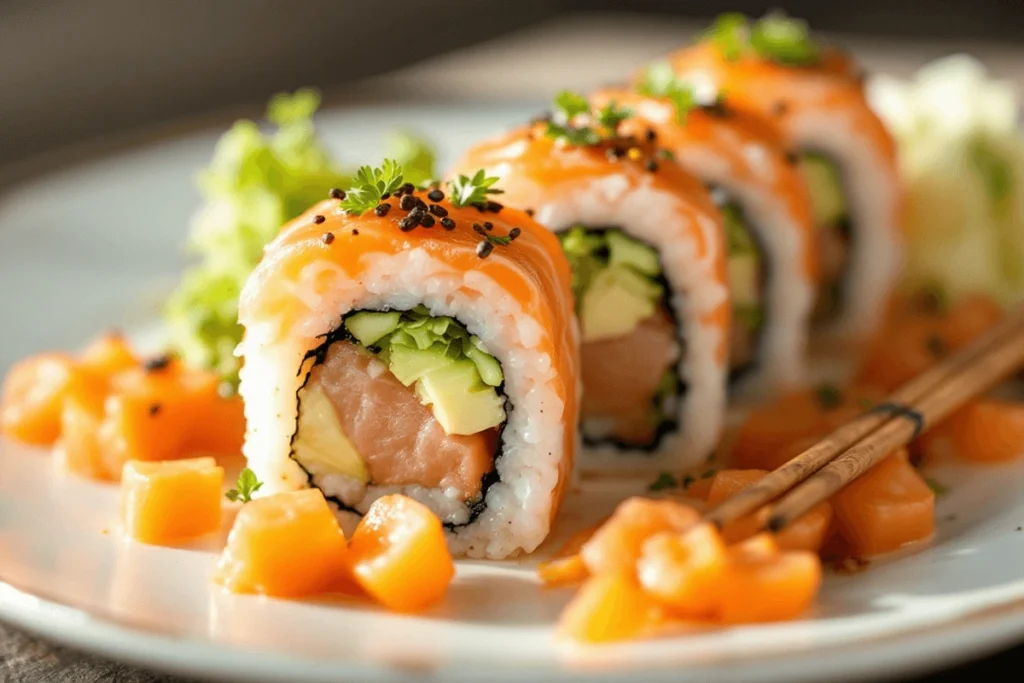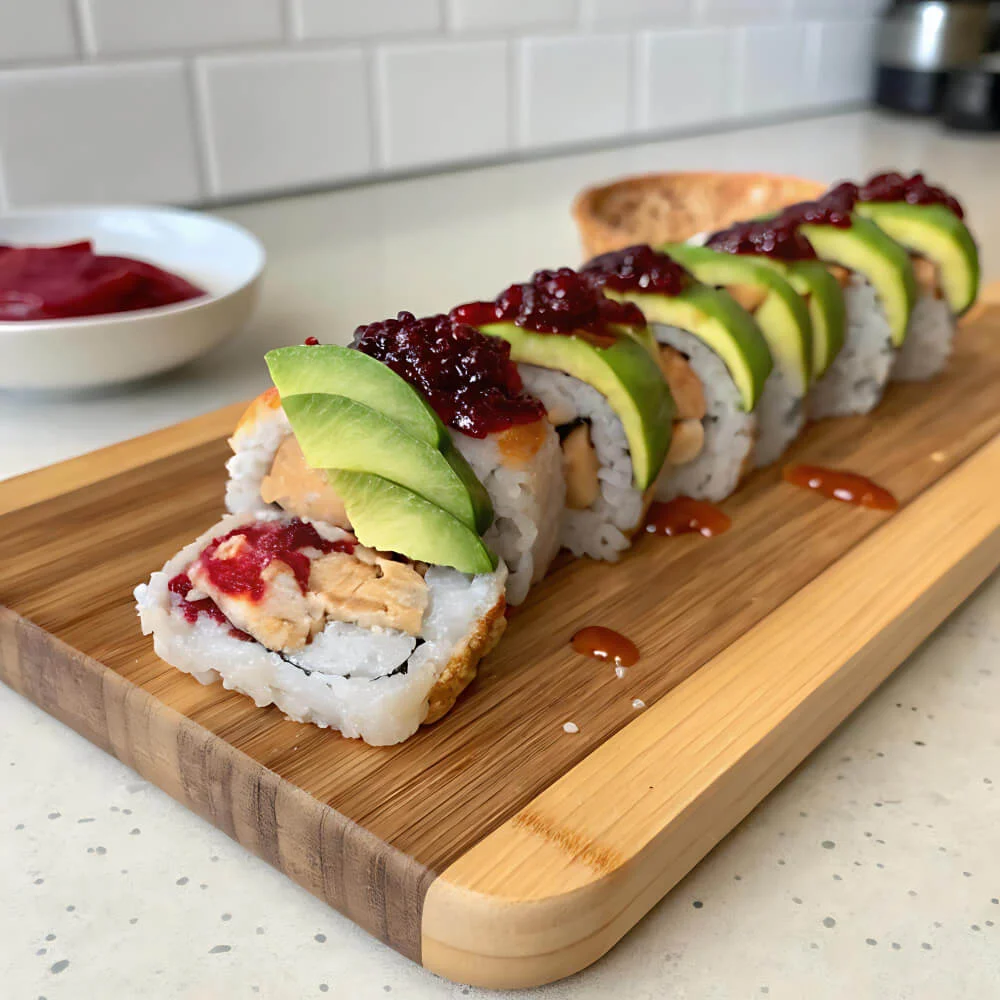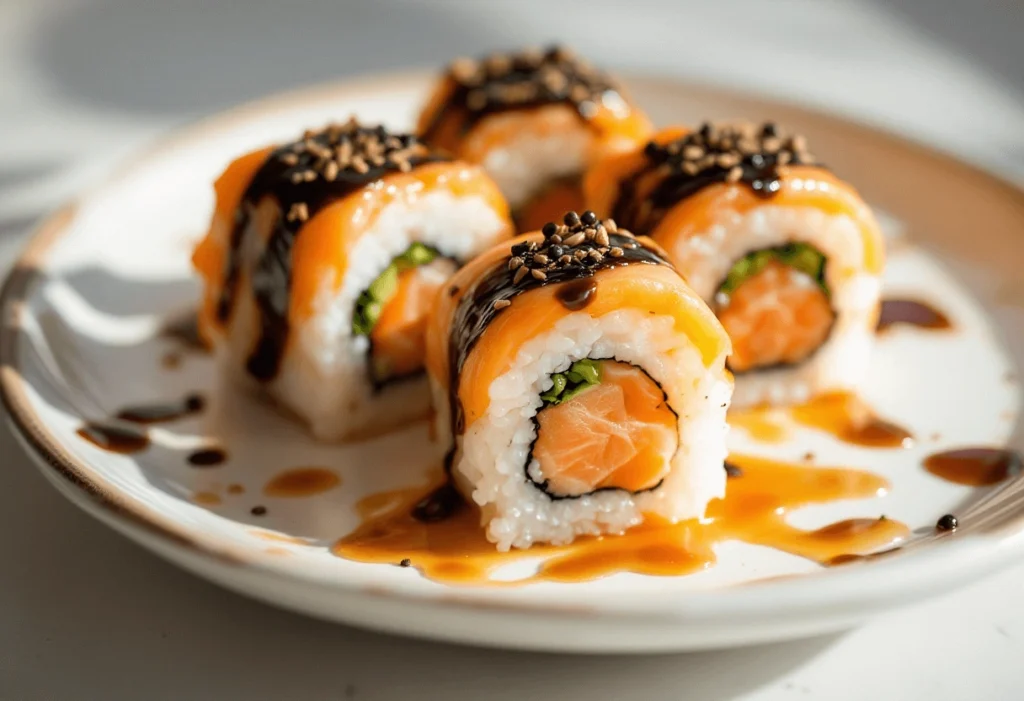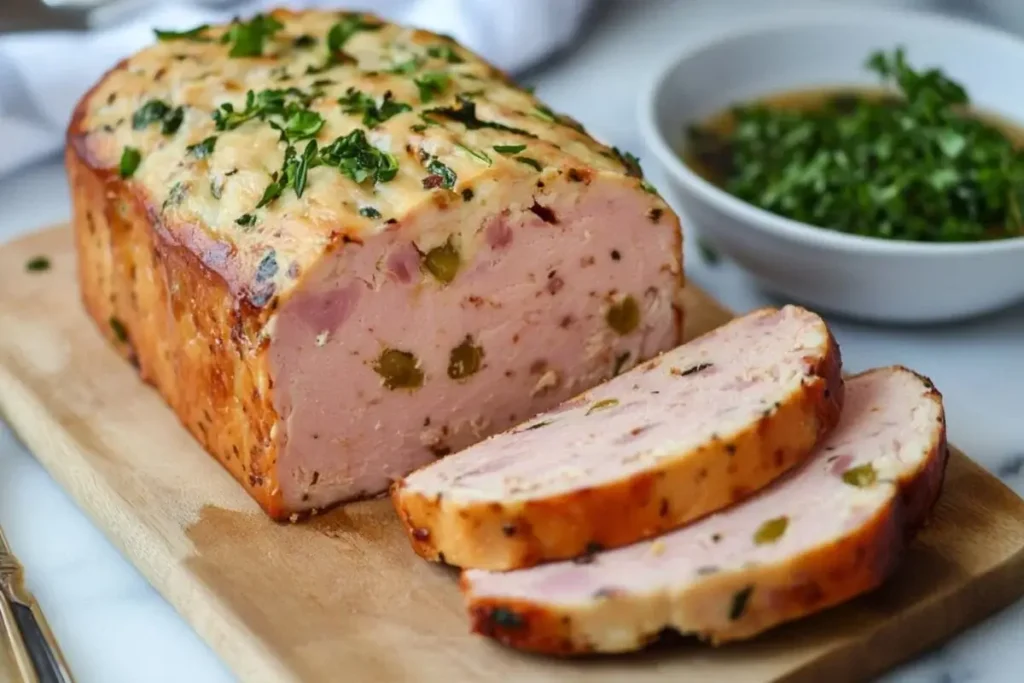
Introduction
Smoked salmon sushi roll is a perfect fusion of delicate textures, rich flavors, and culinary craftsmanship. Unlike traditional raw salmon sushi, smoked salmon adds a savory depth, silky texture, and a subtle smokiness that enhances every bite.
These rolls are considered a gourmet delight for several reasons:
- Balanced Flavors – The mild smokiness of the salmon pairs beautifully with creamy avocado, crisp cucumber, and seasoned sushi rice.
- Luxurious Texture – The contrast between the silky salmon, sticky rice, and crunchy vegetables creates a well-rounded bite.
- Versatile and Customizable – Smoked salmon sushi can be enjoyed as classic maki rolls, inside-out rolls (uramaki), or even in hand rolls (temaki).
- No Need for Raw Fish – Smoked salmon provides an alternative for those who love sushi but prefer not to eat raw seafood.
The History of Smoked Salmon in Sushi
The Introduction of Smoked Salmon to Japanese Cuisine
Traditional Japanese sushi primarily features fresh, raw fish such as tuna (maguro), yellowtail (hamachi), and raw salmon (sake). Smoked salmon, however, was not originally part of Japanese culinary traditions.
- Salmon in Japan was historically grilled or cured rather than eaten raw due to concerns about parasites in local wild salmon.
- Smoked salmon, which has a longer shelf life and a unique flavor profile, became an appealing ingredient as global food influences began to shape modern sushi trends.
- The introduction of smoked salmon into Japanese cuisine was largely influenced by international trade and Western culinary preferences, particularly from regions where smoked and cured fish were already popular.
How Western Influence Popularized Smoked Salmon Rolls
The rise of Western-style sushi, especially in the United States and Europe, played a significant role in popularizing smoked salmon as a sushi ingredient.
- The California Roll Revolution: In the 1960s and 70s, sushi chefs in North America adapted traditional Japanese sushi to Western tastes. This led to the invention of fusion rolls, including the famous California roll, which used imitation crab and avocado instead of raw fish.
- Smoked Salmon in Sushi Restaurants: As sushi gained popularity in Western countries, chefs began experimenting with locally available ingredients, leading to the widespread use of smoked salmon in sushi rolls.
- Iconic Rolls Featuring Smoked Salmon: Rolls such as the Philadelphia Roll (smoked salmon, cream cheese, and cucumber) and various smoked salmon avocado rolls became instant favorites.
Essential Ingredients for the Perfect Smoked Salmon Sushi Roll
A well-made smoked salmon sushi roll relies on high-quality ingredients and proper preparation techniques. From the perfect sushi rice to the right type of smoked salmon and nori, each element plays a key role in creating a balanced and flavorful roll.
1. Choosing High-Quality Smoked Salmon
The smoked salmon is the star of the roll, so selecting the best quality ensures rich flavor and a smooth texture.
- Cold-Smoked vs. Hot-Smoked: Cold-smoked salmon is silky and delicate, making it ideal for sushi. Hot-smoked salmon is firmer and flakier, which works better for sushi bowls or hand rolls.
- Wild-Caught vs. Farmed: Wild-caught salmon typically has a deeper color and more complex flavor, while high-quality farmed salmon can be buttery and rich.
- Low-Sodium Options: Some smoked salmon varieties are heavily salted. Look for a balanced salt level to avoid overpowering the other ingredients.
- Thinly Sliced: Sushi rolls require thin, even slices for easy rolling and a seamless texture.
2. The Best Type of Sushi Rice and How to Season It
Sushi rice (shari) is the foundation of any sushi roll, providing both texture and subtle flavor.
- Type of Rice: Use short-grain Japanese rice (such as Koshihikari) for its sticky, slightly chewy texture.
- Proper Cooking: Rinse the rice several times until the water runs clear to remove excess starch. Cook with the right rice-to-water ratio for perfectly tender grains (typically 1:1 for stovetop cooking, slightly more water for rice cookers).
- Seasoning: After cooking, gently fold in a mixture of:
- Rice vinegar (¼ cup per 2 cups of rice) – Adds a mild tang.
- Sugar (1 tablespoon per 2 cups of rice) – Balances acidity.
- Salt (½ teaspoon per 2 cups of rice) – Enhances flavor.
- Let the rice cool to room temperature before rolling to prevent the nori from becoming too soft.
3. Nori (Seaweed): Selecting the Right Kind for Rolling
Nori (seaweed) holds the roll together and provides a slightly savory, umami-rich contrast to the smoked salmon.
- Grades of Nori:
- Gold or Silver Grade: High-quality, dark green nori with a crisp texture and rich umami taste.
- Lower-Grade Nori: Lighter in color and more brittle, making it harder to roll without tearing.
- Size Matters: Standard half-sheets (8 x 4 inches) are ideal for sushi rolls, but full sheets can be used for larger rolls or hand rolls.
- Storage: Keep nori in an airtight container to prevent it from absorbing moisture, which can make it chewy instead of crisp.
Step-by-Step Recipe for Smoked Salmon Sushi Rolls
Making sushi at home is easier than it looks, as long as you prep the ingredients properly and follow the right rolling technique.
Preparing and Seasoning the Sushi Rice
- Rinse the Rice: Wash the sushi rice under cold water until the water runs clear. This removes excess starch, preventing stickiness.
- Cook the Rice: Use a rice cooker or stovetop method to cook the rice with the correct water ratio.
- Season the Rice: While the rice is still warm, gently fold in the rice vinegar, sugar, and salt mixture. Let the rice cool to room temperature before rolling.
Assembling the Roll: Layering Smoked Salmon and Other Fillings
Classic Smoked Salmon Roll Fillings:
- Smoked salmon – Thinly sliced for easy rolling.
- Avocado – Creamy texture that balances the smoky flavor.
- Cucumber – Adds a refreshing crunch.
- Cream cheese (optional) – For a Philadelphia Roll-style variation.

Assembling the Roll:
- Place a sheet of nori on a bamboo sushi mat (shiny side down).
- Spread an even layer of sushi rice (about ¾ cup) over the nori, leaving a ½-inch border at the top.
- Layer the fillings horizontally across the lower third of the rice.
- Add a light spread of wasabi or spicy mayo (optional) for extra flavor.
Rolling Techniques: Traditional vs. Inside-Out Rolls
Traditional Maki Roll (Nori on the Outside)
- Lift the edge of the bamboo mat and begin rolling tightly but gently, pressing lightly to shape the roll.
- Use a few drops of water on the top edge of the nori to seal the roll.
- Slice with a sharp knife, cleaning the blade between cuts for neat slices.
Inside-Out Roll (Uramaki – Rice on the Outside)
- Spread sushi rice on the nori and flip it over so the rice faces down.
- Place the smoked salmon and fillings on the nori side.
- Roll carefully using the bamboo mat, ensuring the rice stays on the outside.
- Optionally, coat the roll in sesame seeds or tobiko (fish roe) before slicing.
Expert Tips for Achieving the Best Sushi Roll Texture
Perfecting the texture of smoked salmon sushi rolls requires balanced rice, precise rolling techniques, and avoiding common mistakes. Here’s how to ensure your rolls turn out smooth, well-formed, and restaurant-quality every time.
How to Prevent Sushi Rice from Being Too Sticky or Dry
Sushi rice should be slightly sticky but not mushy, holding the roll together without being too firm or dry.
- Use the Right Rice-to-Water Ratio: Too much water makes rice mushy; too little results in dry, hard grains. A 1:1 ratio works well for rice cookers, but stovetop methods may require slightly more water.
- Rinse Thoroughly Before Cooking: Rinse sushi rice under cold water until the water runs clear to remove excess starch. This helps prevent over-stickiness.
- Let the Rice Cool Properly: Hot rice can become gummy when rolled. Let it cool to room temperature in a wide bowl, gently fluffing it with a wooden spoon to avoid crushing the grains.
- Moisten Your Hands When Handling Rice: Lightly dampen your hands with water or a vinegar-water mixture to prevent the rice from sticking too much.
Achieving the Perfect Roll Without Breaking the Nori
Nori sheets can tear or become chewy if not handled correctly.
- Use High-Quality Nori: Choose dark, thick nori with a crisp texture. Lighter, lower-quality seaweed can break easily.
- Keep Nori Dry Until Rolling: Moisture from rice or fillings can make nori chewy. Work quickly to prevent it from softening too soon.
- Don’t Overfill the Roll: Too many ingredients make rolling difficult and can cause the nori to tear. Keep the filling layer thin and evenly distributed.
- Apply Gentle, Even Pressure While Rolling: Use a bamboo sushi mat and press lightly but firmly as you roll to keep everything intact.
Common Mistakes and How to Fix Them
Mistake: The Roll Falls Apart When Sliced
Solution: Roll tightly using a bamboo mat, and let the roll sit for a minute before slicing. Use a sharp knife dipped in warm water to prevent sticking.
Mistake: The Rice Is Too Sticky and Hard to Handle
Solution: Wet your hands with water or a mixture of water and rice vinegar before handling the rice.
Mistake: The Sushi Roll Is Too Dry or Tough
Solution: Make sure the rice has enough seasoning and isn’t overcooked. Store nori sheets in an airtight container to keep them crisp.
Creative Variations of Smoked Salmon Sushi Rolls
Smoked salmon sushi is versatile, allowing for unique flavors and adaptations to suit different preferences.
Smoked Salmon and Cream Cheese Roll (Philadelphia Roll)
This popular fusion roll is creamy, flavorful, and rich, offering a blend of textures.
Ingredients:
- Smoked salmon
- Cream cheese
- Cucumber or avocado
- Sushi rice
- Nori
How to Make It:
- Spread sushi rice on a nori sheet.
- Add a thin layer of cream cheese, smoked salmon, and cucumber in the center.
- Roll tightly using a bamboo mat.
- Slice and serve with soy sauce or a drizzle of eel sauce for extra flavor.
The Philadelphia Roll is a favorite for those who enjoy sushi with a creamy texture and a slight Western twist.
Spicy Smoked Salmon Sushi Roll with Sriracha Mayo
For those who love a little heat, this roll combines spicy mayo with the rich smokiness of salmon.
Ingredients:
- Smoked salmon
- Avocado
- Cucumber
- Sushi rice
- Nori
- Spicy mayo (Sriracha mixed with Japanese mayonnaise)
How to Make It:
- Spread sushi rice on a nori sheet.
- Add thinly sliced smoked salmon, avocado, and cucumber in the center.
- Roll tightly and slice into pieces.
- Drizzle spicy mayo over the top and garnish with sesame seeds or green onions.
Keto and Low-Carb Smoked Salmon Rolls Without Rice
For a low-carb alternative, replace sushi rice with healthier options while keeping the flavors fresh and balanced.
Ingredients:
- Smoked salmon
- Avocado
- Cucumber
- Nori
- Cream cheese or mashed cauliflower rice (optional)
How to Make It:
- Lay a sheet of nori flat on a bamboo mat.
- Layer thin slices of smoked salmon directly on the nori.
- Add avocado, cucumber, and a thin layer of cream cheese (optional).
- Roll carefully, using firm pressure to hold everything together.
- Slice and serve with soy sauce or coconut aminos for a keto-friendly dipping option.
Best Dipping Sauces and Side Pairings for Smoked Salmon Sushi Rolls
Pairing the right sauces and sides with smoked salmon sushi rolls enhances the flavor, texture, and overall dining experience. Whether you prefer a classic umami dip or a bright citrus twist, these options will elevate your sushi.
Classic Soy Sauce with Wasabi
- Why It Works: Soy sauce adds a salty, umami depth, while wasabi provides a sharp, spicy kick that enhances the smoked salmon’s richness.
- How to Use It:
- Dip the sushi roll lightly into low-sodium soy sauce to avoid overpowering the delicate flavors.
- Mix a small amount of wasabi into the soy sauce for extra heat.

Ponzu Sauce for a Citrus Twist
- Why It Works: Ponzu sauce is a tangy, citrus-based soy sauce that adds a refreshing brightness to smoked salmon sushi.
- How to Use It:
- Combine soy sauce, fresh lemon juice, rice vinegar, and a dash of mirin for a homemade ponzu.
- Serve it as a light dipping sauce or drizzle a small amount over the sushi for an extra flavor boost.
Pickled Ginger and Miso Soup as Accompaniments
- Pickled Ginger (Gari):
- Why It Works: Ginger cleanses the palate between bites, allowing you to fully enjoy the flavors of each roll.
- How to Serve: Eat a small slice between different sushi pieces rather than placing it directly on the sushi.
- Miso Soup:
- Why It Works: A warm, umami-rich miso soup balances the cool, creamy texture of smoked salmon sushi.
- How to Serve: Add tofu, seaweed, and scallions for a complete side dish.
How to Store and Keep Smoked Salmon Sushi Fresh
Sushi is best enjoyed fresh, but if you have leftovers, proper storage is essential to maintain flavor and texture while preventing spoilage.
The Best Way to Store Leftover Sushi Rolls
- Wrap Tightly in Plastic Wrap: Wrap individual rolls in plastic wrap or parchment paper to keep them fresh and prevent drying.
- Store in an Airtight Container: Place wrapped sushi in an airtight container to prevent moisture loss and absorption of other fridge odors.
- Refrigerate Properly:
- Store at 40°F (4°C) or lower to keep the smoked salmon fresh.
- Consume within 24 hours for the best taste and food safety.
How to Prevent the Rice from Drying Out
Refrigerated sushi rice tends to harden due to moisture loss. Here’s how to keep it soft:
- Use a Damp Paper Towel: Before refrigerating, place a lightly damp paper towel over the sushi rolls and seal them in an airtight container. This helps retain some moisture.
- Avoid Microwaving Directly:
- If necessary, place sushi in a covered container with a warm damp paper towel and microwave for 10-15 seconds to slightly soften the rice.
- Bring to Room Temperature Before Eating: Let sushi sit out for 15–20 minutes before eating to restore its natural texture.
FAQs: Smoked Salmon Sushi Rolls
Can I use hot smoked salmon instead of cold smoked salmon?
Yes, but it will change the texture and flavor of the sushi roll.
- Cold-Smoked Salmon – The traditional choice for sushi rolls, offering a silky, delicate texture and a mild smoky flavor.
- Hot-Smoked Salmon – Firmer and flakier, with a stronger smoky taste. It works well in hand rolls, sushi bowls, or as a filling mixed with cream cheese but may not roll as smoothly as cold-smoked salmon.
How do I keep my nori from becoming too chewy?
Chewy or tough nori can make sushi rolls difficult to eat. To keep it crisp and easy to bite into:
- Use High-Quality Nori: Choose dark green, premium-grade nori that is crisp and slightly shiny. Lower-quality nori tends to be thicker and chewier.
- Store Nori Properly: Keep it in an airtight container or resealable bag to prevent moisture absorption, which makes it chewy.
- Assemble Sushi Rolls Just Before Serving: Once exposed to moisture from the rice, nori softens. If making sushi in advance, keep the rolls wrapped tightly in plastic wrap.
- To Restore Crispness: If nori has softened, briefly toast it over low heat for a few seconds before rolling to bring back some of its crisp texture.
Can I make smoked salmon sushi rolls ahead of time for an event?
Yes, but for the best texture and flavor, follow these preparation and storage tips:
- Make Sushi No More Than a Few Hours in Advance: Sushi is best when freshly made, but you can prepare rolls 2–4 hours before serving if stored properly.
- Wrap Rolls Tightly in Plastic Wrap: This helps keep moisture in and prevents the nori from becoming too chewy or soggy.
- Store in an Airtight Container in the Refrigerator: Place a lightly damp paper towel over the sushi before sealing the container to prevent the rice from drying out.
- Bring to Room Temperature Before Serving: Let the sushi sit out for 15–20 minutes before serving to restore its natural texture.
What’s the difference between smoked salmon and raw salmon in sushi?
Both smoked salmon and raw salmon are used in sushi, but they offer different textures and flavors.
| Feature | Smoked Salmon | Raw Salmon (Sashimi-Grade) |
|---|---|---|
| Texture | Silky, slightly firm | Soft, buttery |
| Flavor | Mildly smoky, salty | Fresh, rich, slightly sweet |
| Preparation | Cured and smoked | Fresh and raw (must be sushi-grade) |
| Best Used In | Rolls, hand rolls, sushi bowls | Sashimi, nigiri, traditional rolls |
| Storage | Lasts longer due to curing process | Needs to be eaten fresh |
Conclusion
Smoked salmon sushi roll offer a delicious blend of traditional Japanese flavors with a modern twist, making them a popular choice for sushi lovers of all levels. Their silky texture, subtle smokiness, and balanced ingredients create a gourmet experience that is both satisfying and easy to prepare at home.
By selecting high-quality smoked salmon, properly seasoned sushi rice, and crisp nori, you can achieve a perfectly rolled, flavorful sushi dish. Whether you prefer classic pairings like soy sauce and wasabi, a citrusy ponzu drizzle, or creative variations like spicy mayo and cream cheese, there are countless ways to customize your sushi rolls
Viral Tuna Salad: 5 Bold Reasons Matthew McConaughey’s Recipe Wins
Healthy Homemade Chicken Mortadella
Chicken Mortadella changed my deli game forever. I used to stare at processed meat…
The BEST Taco Pasta
When I’m short on time and need to get a satisfying dinner on…
Classic German Kartoffelpuffer Recipe (Authentic, Crispy & Easy to Make)
Easy Butter Pecan Cookies Recipe
There’s something undeniably comforting about the scent of buttery, nutty cookies wafting from…
Perfect Strawberry Cheesecake Recipe
If there’s one dessert that’s guaranteed to silence a lively room, it’s this…







3 thoughts on “Smoked Salmon Sushi Roll”